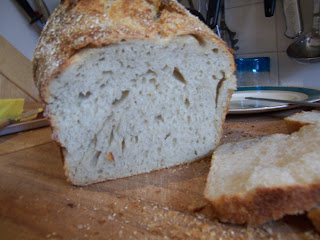Baked in a square tin in my gas oven, this golden loaf...
 |
| Sourdough square loaf inside |
... has a moist, chewy texture. A true Sourdough.
 |
| Sourdough long loaf |
From the pizza slab, fresh farm-style bread
 |
| Sourdough - dough stage |
A flat foccaccia-style loaf rests on my pizza stone before going in to the oven.
And comes out rustic and golden
 |
| Sourdough - dinner or lunch rolls and a loaf |
Economy day - A loaf and 4 buns
 |
| Sourdough blueberry bagels |
These were some truly awesome blueberry bagels... boiled, then baked, glazed with sugar and stuffed with fresh blueberries.
 |
| Sourdough bagels with cinnamon, blackstrap and blueberries |
So I had to keep going. I then made a richer, darker bagel with cinnamon, blueberries and blackstrap molasses.
 |
| Sourdough buttery croissants |
Tried bagels... why not croissants? It requires a bit of elbow grease to work in the butter, so it layers, but it's so worth it!
 |
| Sourdough hi-top loaf of bread |
A VERY hi-top loaf...
 |
| A fine slice of bread |
...with a light, chewy middle
 |
| Sourdough round loaf in pot |
The classic method of baking in a covered iron pot produces a rich, caramel colour.
 |
| Sourdough round loaf |
Another beautiful round country-style loaf
 |
| Fresh bread and butter - sourdough style |
... and the only way to have it is with unsalted, cultured butter.
 |
| Twin sourdough loaves baked in silicon tins |
A pair of twins, from the oven. My first attempt at baking in silicone trays - not my favourite!
 |
| Sourdough pizza |
As an Italian mamma said to me, "the taste is all in the base". While she had a wood stove in her Bondi garage, these pizzas made in my gas stove are not only the most popular item in my house, but they taste even better than her wood fired ones. She should have used sourdough starter instead of yeast!






